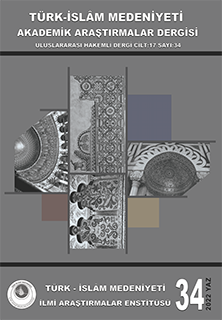Bahri Memlûkların Siyasi Anlaşmalarında Ticaret ile İlgili Olan Maddeler
DOI:
https://doi.org/10.5281/zenodo.6526411Anahtar Kelimeler:
Memlûklar, Ticaret, Templier Şövalyeleri, AkkâÖzet
Bu çalışmada Bahrî Memlûkların tesis ettikleri siyasi anlaşmalarda ticaret ile ilgili olan maddeler ele alınmıştır. Haçlılar çağının devam ettiği süreçte, Memlûklar, selefleri Eyyubiler gibi Haçlılar ile olan siyasal mücadeleleri sürdürdüler. Taraflar arasında süre gelen savaşların yanı sıra siyasi ve iktisadi çıkarların devamını sağlamaya yönelik pek çok anlaşma da akdedilmiştir. Bu anlaşmalar genelinde dikkati çeken hususlardan birisi de ticaret ve tüccarları ilgilendiren pek çok maddeye yer verilmiş olmasıdır. Bu durum anlaşmaya taraf olanların, uluslararası ticaretin muntazaman devam etmesi hususuna verdikleri önemin görülmesi açısından önemlidir. Ülkelerin ihtiyacını duydukları ithal malların arzlarını temin etmelerinin yanı sıra tüccarlar, ticaretini yaptıkları mal ve emtia üzerinden ödedikleri gümrük vergileri münasebetiyle devletlerin kayda değer bir gelir kaynağını da teşkil ediyordu. Ortaçağ pek çok bakımdan olduğu kadar ticaret faaliyetleri münasebetiyle farklı ülkelere gitmek zorunda olan tüccarlar için de riskli bir dönemdi. Bilhassa iki devlet arasında süregelebilecek herhangi bir savaş yahut siyasal gerilimden bölge halkları kadar ticaret ve tüccarlar da olumsuz yönde etkilenebiliyordu. Bu nedenle ticaret yolları ile tüccarların can ve mal güvenlikleri ve zarara uğrayan tüccarların mallarının devlet garantisi altında olması gibi bazı ticari hususlar siyasi anlaşmalarda yer eden birçok madde ile teminat altına alınmış ve bu suretle uluslararası ticaretin kesintisiz devamı hedeflenmiştir.
Referanslar
Ağır, A. M. (2015). Memlûklarda Ticaret. Konya: Çizgi Kitapevi.
--------, (2008). Sultan Kalavun Devri Memlûk-İlhanlı Münasebetleri II. Humus Savaşı H. 679/M. 1281. Akademik Bakış, S: 15, Ekim 2008, s. 1-10.
Aka, İ. (2013). Timur ve Timurlular. Orta Asya Türk Tarihi, ed. Ahmet Kanlıdere, Eskişehir.
Altan, E. (2002). Templier ve Hospitalier Şövalye Tarikatlarının Kuruluşu. Belleten, 245, s. 87-93.
Ashtor, E. (1956). The Kārimī Merchants. The Journal of the Royal Asiatic Society of Great Britain and Ireland, Cambridge University Press, 1/2, s. 45-56.
Ayalon, D. (1989). Memlûklarda Kölelik Sistemi. Trc. Samira Kortantamer, Tarih İncelemeleri Dergisi, IV, s. 221-234.
Barker, H. (2019). That Most Precious Merchandise: The Mediterranean Trade in Black Sea Slaves, 1260-1500, Philadelphia: University of Pennsylvania Press, s. 160-161.
Carr, J. (2016). The Knights Hospitaller: A Military History of the Knights of St John, South Yorkshire: Casemate Publishers.
Cook, (2020). Chronicles of Qalāwūn and his son al-Ashraf Khalīl, New York: Routledge.
Demirkent, I. (1996). Haçlılar. DİA, C. 4, İstanbul: Türkiye Diyanet Vakfı Yayınları, 1996, s. 525-546.
Gabrieli, F. (2010). Arab Historians of the Crusade, trs. E. J. Costello, Routledge: Tylor&Francis.
Heyd, W. (2000). Yakındoğu Ticaret Tarihi, çev. Enver Ziya Karal, T.T.K. Yay., Ankara.
Holt, P. M. (1995). Early Mamluk Diplomacy (1260-1290): Treaties of Baybars and Qaläwün with Christian Rulers, Islamic History and Civilization, ed. Ulrich Haarmann, v. 12, New York and Köln: Brill Leiden.
Howard, D. (2007). Venice and the Mamluks. Venice and the Islamic World 8281797), Paris: Yale University Press, s. 72-89.
İbn ‘Abdü’z-Zâhir, Muhyîd-Dîn. (1961). Teşrîfü’l-Eyyâm ve’l-’Usûr fî Siretü’lMelikü’l-Mansûr, nşr. Murad Kâmil, Kahire.
İbn ‘Abdü’z-Zâhir, Muhyîd-Dîn. (1976). Er-Ravdü’z-Zâhir fi Siretü’l-Melikü’zZâhir, nşr. Abdülaziz el-Huvaytir, Riyad 1976.
Preiss, R. A. (2004). Mongols and Mamluks: The Mamluk-Ilkhanid War, 1260-1281, Cambridge: Cambridge University Press.
Kalkaşendi, Ebü’l-Abbas Şehabeddin Ahmed b. Ali b. Ahmed. (1919). Subhü’lS’şa fî Sınaati’l-İnşa, XIV, Kahire: el-Matbaatü’l-Emirîye.
Kanat, C. (2001). Baybars Zamanında Memlûk-İlhanlı Münasebetleri 1260-1577. Tarih İncelemeleri Dergisi, 16, s. 31-46.
Lockhart, L. (1986). European Contacts Wıth Persıa, 1350-1736. Cambridge History of Iran, ed. Peter Jackson, Cambridge University Press: New York, s.373411.
Makrizi, Par Takieddin Ahmed. (1837). Histoire des Sultans Mamlouks de l’Égypte, trs. Étienne Marc Quatremère, Oriental Translation Fund of Great Britain and Ireland.
Özbek, S., Çıplak, E. (2017). “Memlûkler ve Haçlılar Arasındaki Antlaşmalarda On Yıl Kuralı”, Kerkük Çok Uzak Değil Prof. Dr. Eşref Buharalıya Armağan, Gece Kitaplığı, Ankara, s. 57-70.
Sabra, A. (2006). Poverty and Charity in Medieval Islam Mamluk Egypt 1250-1517, Cambridge Studies in Islamic Civilisation, Cambridge.
Sağlam, A. (2017). Suriye’de Hâkimiyet Mücadelesi: İlhanlılar&Memlûklar (12981304), İstanbul: Çamlıca Kitapevi.
Skaria, M. K. (1983). Portuguese trade with India in the Sixteenth Century. New Delhi Manohar.
Smith, J. R. (2012). The Knights Hospitaller in the Levant, c.1070–1309, New York: Palgrave Macmillan.
Steward, A. D. (2001). The Armenian Kingdom and the Mamluks: War and Diplomacy During the Reigns of Hetʻum II (1289-1307), Leiden: Brill.
Tsugitaka, S. (2006). “Slave Traders and Kārimī Merchants”, Mamluk Studies Review, X-1, s.141-232.
Yiğit, İ. (2001). Kalavun. DİA, Türkiye Diyanet Vakfı Yayınları c.XXIV, İstanbul, s. 227-228.
İndir
Yayınlanmış
Nasıl Atıf Yapılır
Sayı
Bölüm
Lisans

Bu çalışma Creative Commons Attribution-NonCommercial 4.0 International License ile lisanslanmıştır.







